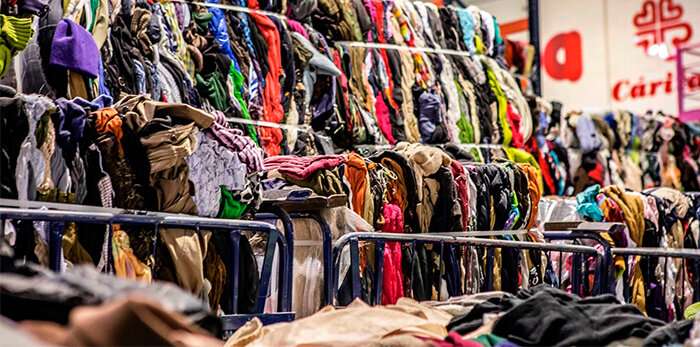Reusing 1 kg of clothing saves 25 kg of CO2, study finds

The UPC's INTEXTER has conducted an analysis to calculate the share of fibers used in the clothes that are dumped in textile collection bins. The study uses an innovative methodology and is therefore more accurate than other approaches so far.
About 550 kg of clothes from the Formació i Treball Foundation clothing bins have been analyzed in the first study ever to characterize the fibers that make up T-shirts, shirts, coats, trousers, jackets and other kinds of clothing that are dumped in textile collection bins.
According to INTEXTER researchers, of all used clothes from the bins, 62% are reusable and 37% are recyclable. The study concludes that the most common fiber is cotton, with 50% in recyclable clothes and 60% in reusable clothes. Polyester follows, with 30% in both types. Therefore, cotton and polyester account for about 80% in recyclable clothing and 88% in reusable clothing.
Acrylic fibers account for a much lower percentage. The study shows a large difference between recyclable clothing (12.4%) and reusable clothing (3.1%), because clothing made from these fibers is the most readily deteriorated.
The characterization has been possible through an innovative methodology based on crushing garments and standardizing the mixture by means of two steps: (1) automatic carding and (2) analyzing the resulting webs using the standardized chemical methodology. The result allows for the determination of the composition of textile products, including the standard moisture regain of every fiber.
Focusing on cotton and polyester
INTEXTER Director Enric Carrera says, "In light of the analysis, we can say that the recycling strategy of post-consumer textile waste should focus on recovering and reusing 80% of the predominant fibers, namely cotton and polyester."
The study also includes an analysis of the fiber composition of clothing on the websites of major brands. A total of 701 garments were analyzed, corresponding to the first 30 items in six major categories (T-shirts, jumpers, jeans, underwear, socks and shirts) at Zara, H&M, C&A and Mango. In this case, the analysis does not include jackets or coats.
The analysis reveals that 66.8% of garments contain mixed fibers, which significantly limits their recycling potential. Only 37.3% of the garments studied are 100% made with a single fiber.
As for home textiles, 361 items were analyzed, corresponding to the first 20 items in four major categories (sheets, towels, tablecloths and curtains) at Ikea, Zara Home, H&M Home, 10xDIEZ and Carrefour. Unlike clothing, home textiles are predominantly made of a single material. The most common fibers are cotton, polyester, linen, viscose and lyocell, in that order. Sheets and towels are mainly made from 100% cotton, whereas tablecloths and curtains from 100% polyester, although binary mixtures of cotton and polyester or cotton and linen are also used.
Extending the life of garments
How much would we reduce our environmental impact by reusing used clothing? Carrera says, "If we could double the lifespan of garments, we would be reducing the fashion industry's greenhouse gas emissions by 44%. Extending the active life of clothing by just nine months would already reduce carbon, water and waste footprint by 20–30%. An increase of 10% in second hand sales could save 3% of carbon emissions and 4% of water, according to data from the report Valuing our clothes: the cost of U.K. fashion, published by WRAP in 2017."
The UPC's INTEXTER has carried out an extensive bibliographic review of existing studies on how much CO2 is saved by reusing clothing. It has concluded that reusing 1kg of clothing saves 25 kg of CO2, unlike EU estimates so far, which suggested only 3.169 kilos.
Provided by Universitat Politècnica de Catalunya


















